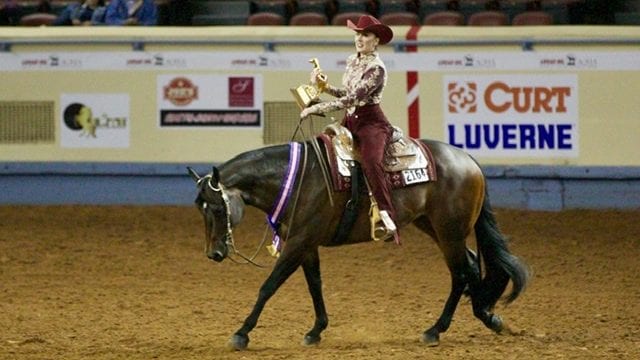According to the 2019 AQHA Rulebook, horsemanship is a class that, “is designed to evaluate the rider’s ability to execute, in concert with their horse, a set of maneuvers prescribed by the judge with precision and smoothness while exhibiting poise and confidence and maintaining a balanced, functional and fundamentally correct body position.”
AQHA Judges Terry Cross and Melissa Dukes further explore this topic.
Correct gaits – One of the essential parts of a good horsemanship pattern is letting your horse show off his natural strides. Don’t try to collect them to the point where the gait looks broken.
“I want a horse that is good cadenced,” Cross said. “He doesn’t have to be a western pleasure-type mover, but he needs to have good rhythm and a definite two-beat trot and three-beat canter. Sometimes we have the horse who knows his tricks but maybe isn’t as cadenced, and he takes away from the rider because he’s not as smooth since his gaits aren’t as good.”
If your horse doesn’t have those correct, smooth gaits in horsemanship, then your form as a rider could be compromised.
“I like to see a horse that has the true cadence in each gait,” said Dukes. “For a trot, I want the correct two-beat gait. Same for the lope and the extended lope. I want a definite difference in each of those gaits.”
Don’t be afraid to push a horse, especially in the extended gaits.
A content demeanor – When you’re executing a pattern, it should look like both you and your horse are having fun.
“I want to see a horse that is enjoying his job and is not sour, pinning his ears, or swishing his tail,” Dukes said. “I want a horse that looks like he’s happy doing it. It presents a more pleasing overall picture if it looks like the horse and the rider are enjoying their job.”
Personality – Horses have all types of personalities. While this isn’t the most crucial thing in the world, it still is essential.
“You know, we lean towards that quieter horse that can be pushed around,” Cross said. “The most success has come from the quieter-minded ones, that the rider can go ahead and push the horse around, and the horse doesn’t want to get in a hurry.”
While Cross noted that quieter-minded horses usually bring more success to the show ring, it also depends on what type of rider you are.
“The ones that might be considered a little quirky or aware of what you’re asking can work out well if the rider suits that type of horse,” Cross said. “Those horses tend to turn faster and get up there and run a little bit. But, let’s say you’re not a very aggressive rider, and you’re a strong mental rider. Then you can stay ahead of one that wants to get quick in its thinking, and that can work too.”
Knowing their skills – Horsemanship patterns can prove to be tricky, with all types of skills thrown into them. If you want success in the show ring, your horse must have the tricks to complete the patterns accurately.
“You have to have a degree of difficulty somewhere [in patterns],” Dukes said. “That will separate your top, middle, and lower end in your class, whether it’s a spin or an extended gait.”
But, just because a horse doesn’t have those skills, it doesn’t mean that it can’t be taught.
“You want one that is willing, not only in your seat but also your legs, to move forward and to hit all the different maneuvers,” Dukes said. “You can usually pick a horse to train to do the horsemanship. The ones that are a little handier and willing are the ones who are going to excel.”
Cross commented on the importance of body engagement.
“I want a horse that is handy,” he said. “What I mean by that is that he stops good, uses his hindquarters, turns quickly, and gets off and into his transitions smoothly.”
Connection – If you’re going to execute a good horsemanship pattern, the most important thing is that you connect with the horse – physically and mentally.
“You have to ride him enough where you can do whatever on that horse, so you know what it feels like, and that horse knows what you’re asking for,” Dukes said.
Cross pointed out that one of the most important things is that the rider and horse are working together.
“I want that rider to be connected to them, and for it to be easy for them to stay balanced up there in the seat,” he said. “I want to see that they are truly controlling that horse and their horse, and they are in unison. I hope my winner shows me that they are truly in control of that horse, and I believe that they are so in time with their horse that they’re just a good horseman. Don’t be afraid to keep your hand in a centralized area, but don’t be afraid to take hold and show me that you’re controlling that horse.”
Overall, many different types of horses can be successful in horsemanship, keep these tips in mind to shine in the show ring.









